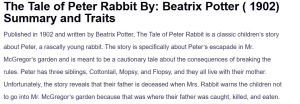The Tale of Peter Rabbit By: Beatrix Potter ( 1902) Summary and Traits
Published in 1902 and written by Beatrix Potter, The Tale of Peter Rabbit is a classic children’s story about Peter, a rascally young rabbit. The story is specifically about Peter’s escapade in Mr. McGregor’s garden and is meant to be a cautionary tale about the consequences of breaking the rules. Peter has three siblings, Cottontail, Mopsy, and Flopsy, and they all live with their mother. Unfortunately, the story reveals that their father is deceased when Mrs. Rabbit warns the children not to go into Mr. McGregor’s garden because that was where their father was caught, killed, and eaten. However, despite this warning, Peter disobeys and sneaks into the garden, indulging in a variety of vegetables while there. Unfortunately, he is spotted by the farmer, who chases him throughout the garden and almost gets caught a few times. Eventually, Peter manages to escape from the garden. Still, in addition to almost losing his life, he loses his new jacket and shoes in the process, making it home terrified and exhausted. Back home, while Peter goes to bed due to his condition, his obedient siblings enjoy a good evening with delicious food. Thus, this story highlights the importance of obedience.
Several picture book traits are used in the story, including rhythm and repetition. Examples are the phrases Flopsy, Mopsy, and Cottontail (Potter para 1-7). Rhymes are significant in picture books because they provide a playful and creative learning opportunity that is important for early development in literacy. Secondly, there is repetition, for example ‘scritch, scratch, scratch, scritch” (Potter, para 5), which serves as a mnemonic device and enables children to remember key details of the story. The second picture book trait is a strong emotional resonance, whereby the tale has emotional weight, with themes like fear and relief being common, especially in the scenes where Peter almost gets caught by the farmer. Managing to get away from the farmer and get home gives one relief because Peter is safe. These two themes have been presented in a way that resonates deeply with the reader.
The third picture book trait is that the story has a clear and simple plot, making it as straightforward as a picture book should be, also known as the economy of language. There is just one journey to focus on, and that is what this particular tale does using concise and to-the-point text. This ensures that it is easy for the reader to follow without any confusion, also making it easy to remember. In addition, the story also contains short text under one thousand words, which is ideal for young readers and follows a simple, direct narrative structure. The structure follows the classic pattern of a conflict, highlights, and ends with a resolution, making it easy for young readers to follow it with ease and it also makes it predictable and comforting. A fourth picture book trait found in the tale is the theme of exploration and discovery. Such themes usually revolve around self-discovery, family, learning about the world, and friendship, among others. They are also written in a way that is accessible to the young reader’s comprehension ability. Lastly, there is perfect harmony between the visuals and the words. The author created a harmonious balance between the text and the images so that each element enhances the other. The images are especially useful in engaging the imagination of a young mind, creating movie-like imagery.
Works Cited
Potter, Beatrix. “The Tale of Peter Rabbit.” American Literature, 2022, https://americanliterature.com/author/beatrix-potter/short-story/the-tale-of-peter-rabbit/
ORDER A PLAGIARISM-FREE PAPER HERE
We’ll write everything from scratch
Question

The Tale of Peter Rabbit By: Beatrix Potter ( 1902) Summary and Traits

